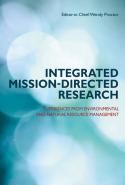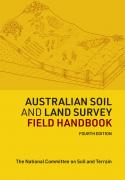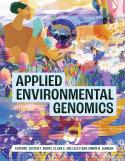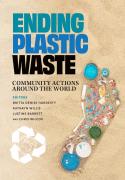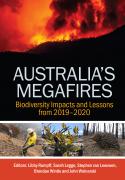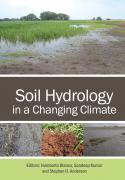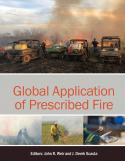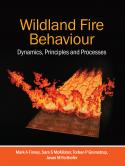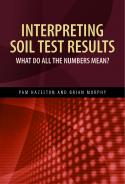This book offers readers the chance to learn from the experiences of researchers involved in integrated mission-directed research, particularly in the areas of natural resource management and regional development.
Integrated Mission-directed Research covers important issues in integration science, supported by case studies that detail how to engage individuals and communities, and support policy decisions and development. The authors explore case studies undertaken in Australia, Europe, Thailand and Indonesia, as well as perspectives from the Millennium Ecosystem Assessment. Closing chapters demonstrate key challenges for researchers and essential questions that should be answered when trying to set up integrated research. Potential benefits that could be obtained from effective integrated mission-directed research are included, as well as assessment questions to assist researchers to see if such benefits have been truly obtained.
Written by experienced researchers, many of whom were involved in CSIRO’s Social and Economic Integration Emerging Science Initiative, the book explores how integrated research is now seen as crucial in achieving sustainability outcomes in natural resource management.
- Page 9Abstract
Throughout human history, people have shared experiences and knowledge. However, since the rise of both economic specialisation through markets and scientific specialisation a century and a half ago, people no longer share as many experiences or as much knowledge. Environmental management requires shared understanding across stakeholders and with the public at large. Although most scientists and the public believe that science will someday lead to some sort of universal understanding available to all, in fact no such unified, accessible understanding exists. The Millennium Ecosystem Assessment organised more than a thousand scientists from multiple disciplines to work together to collectively understand environmental complexities and suggest management options.
- Page 23Abstract
Analysis of the integration approaches taken by two Australian Cooperative Research Centres – the CRC for Greenhouse Accounting and the CRC for Coastal Zone, Estuary and Waterway Management – is used to reflect on (a) six heuristics for understanding integration and (b) a framework of six questions for describing integration. The heuristics are connecting across research silos, a jigsaw, purchaser–provider relationships, extension work, value adding across multiple scales and ‘locked door’ serendipity. The questions examine what the integration is aiming to achieve, what is being integrated, who is doing the integration and how, and investigating the context for the integration and success measures. Both the heuristics and the questions have broader applications. We also examine what integration in research is, along with contexts in which integration occurs, by examining projects, programs and organisations. We conclude by examining institutional aspects of integration, especially governance, funding and accountability, and incentives.
- Page 39Abstract
A 6-month review of current research within the Commonwealth Scientific and Industrial Research Organisation (CSIRO), which sought to explore the interface between science and societal change, has revealed many practical challenges for researchers, the research process and the institutional environments in which this research is managed and funded. Semi-structured interviews were used to elicit, from the experiences of individuals involved in six case study projects, the success factors, challenges and lessons to be learnt by CSIRO within an area of emerging science. The study showed that project teams were engaging and interacting with challenging community, government policy and industrial institutional settings. The process of engaging with people, their experiences and needs confronted traditional ‘top-down’ scientific research dissemination and the way researchers needed to think about tackling research problems.
These projects have shown CSIRO researchers how to stretch themselves across disciplinary boundaries, work cooperatively and to interact with socially complex environments and people. This has encouraged new forms of learning, brought systems understanding to research domains and, through building community consensus and participation processes, has influenced ‘real world’ issues.
Accommodation of this research within the many CSIRO Divisions’ cultural environments brings into focus the transition needed to better accommodate the pursuit of knowledge that is often considered to be less scientifically rigorous, more intellectually challenging and too interpretive in the light of past CSIRO practice. High levels of time, effort and funding are required, and sufficient lead time is needed to plan and organise the research process. The study participants suggested that the existing academic reward system was inadequate and an impediment to the pursuit of integrative research by CSIRO scientists.
- Page 51Abstract
Nature conservation is an area with a high propensity for the collision of values, interests, norms and beliefs. The return of large, charismatic but potentially dangerous predators to their former habitats epitomises many of the conflicts that emerge around environmental issues: scientific uncertainty, conflicting values, divergent interests, and high-profile, often emotive community action: both in favour and against. Yet these conflicts can also present opportunities for engagement and change. This chapter briefly examines theories about environmental conflicts, and draws on the reintroduction of bear species as an example of approaches to conflict resolution. It summarises main challenges faced by researchers attempting to broker good outcomes for both bears and the communities the bears need to live with.
- Page 71Abstract
The conventional approach to mission-directed research assumes that once the problem is framed correctly by development experts, science can get on with its work in exploring solutions that eventually will be forthcoming. This model has serious limitations both for describing how the world actually works and for what might be desirable. In this chapter, we explored three longer term projects conducted in the uplands of northern Thailand that attempted to bring research-based knowledge to bear on problems of development and the environment. From these analyses, we infer a different model: one in which issues of problem definition, scientific discovery and development policy re-making are tangled, at different times informing, challenging and by-passing each other. Further reflection leads us to three broader conclusions: (1) identification of problems is a critical ongoing negotiation in which it pays to be understandable to as wide a range of stakeholders as possible; (2) the effectiveness of engagement by researchers with narrowly defined stakeholder groups or a wider public in their dealings with public policy issues is contingent on the sensibility they bring with them; (3) mission-directed research, because it can be very influential, carries with it ethical responsibilities that may not apply so strongly or frequently as in other kinds of research.
- Page 957. A sociological analysis of the participatory application of agricultural decision-support systemsAbstract
Technologies are important mediators of relationships in integrated mission-directed research. Scientists have attempted to make agricultural systems science more accessible and useful for industry stakeholders through decision-support systems (DSSs). However, the poor uptake of agricultural DSSs by intended users has lead to critical reflection on the way in which these technologies are developed and applied. The current shift towards participatory research, development and application approaches recognises the benefits of fostering collaborative and mutually beneficial relationships between scientists and their stakeholders, but lacks a detailed analysis of the interaction between the multiple parties involved in DSS application. To address this gap, we have analysed the participatory application of DSSs, using concepts from science and technology studies, through a project examining the application of knowledge intensive technologies in the Australian sugar industry.
In this chapter, we outline a theoretical framework for understanding the role of technologies in interactions between scientists and practice communities. The framework focuses on the phases of participatory DSS application, and the likely outcomes of this process. The framework is based on three concepts from science and technology studies: namely interpretative flexibility, technological frames and boundary objects. We reflect on how this framework contributes to understanding the challenges and benefits of integrated, mission-directed research, including the challenges of problem definition and role definition and the potential benefit of generating new knowledge and insights. We argue that participatory DSS application must begin with negotiation of the different perspectives of the scientist and other stakeholders involved in DSS application, with an emphasis on co-learning between experts and local people.
- Page 115Abstract
Managing change is an essential ingredient for sustainable development and requires new approaches to understanding regions and systems. Science for sustainability is increasingly using participatory approaches in combination with quantitative modelling. We report on two recently completed projects that used a regional development framework based on systems thinking in two Australian coastal regions facing intense development pressures. The two regions– the Augusta-Margaret River Shire in Western Australia and the Central Coast in NSW – face similar development pressures but are at opposite ends of the development process. An important component of both projects involved the development of regional-scale simulation models of selected sustainability issues in order to investigate development options. The aim of these models was to produce integrated and logically consistent scenarios of future development in order to stimulate and clarify debate about possible future issues. We discuss the lessons learned from these projects for both the modelling methods and the social learning process in which they were embedded.
- Page 145Abstract
The RTLA project aims to develop a Water Management Plan (WMP) for Western Australian towns that will be used by decision makers to improve the rural town water cycle and supply. To facilitate development of an adequate WMP, the project has adopted a systematic approach to acquiring biophysical data that in itself is essential, but also necessary for subsequent engineering and economic analyses. The approach that was developed enabled a ‘paradigm shift’ from addressing a biophysical problem (water table and salinity effects on infrastructure and natural resources) to the social and economic advancement of the rural town (conservation of biodiversity, reduced water imports from external sources, and economic opportunities from increased supplies of treated, fit-for-purpose water and from products extracted during water treatment). Accordingly, a conceptual system model was designed that integrated all these aspects and required inputs from numerous disciplines, agencies, professions and manufacturing industries. This chapter demonstrates the application of the systems approach in a case study for Wagin, one of the Western Australian towns. It shows that all proposed water management options (groundwater abstraction and disposal to the salt lake, groundwater abstraction, water desalination, permeate sale and brine disposal to the salt lake or evaporation pond) provide benefits for the town site, but to a varying extent, with the greater economic benefit from groundwater abstraction and disposal to the salt lake. Furthermore, to account for town community expectations, technical management considerations and potential uses of desalinated water, the final water management plan should be completed in consultation with the town community.
- Page 165Abstract
A key aspect in integrated mission-directed research is to assist stakeholders and decision makers in evaluating their actions and policies by enabling the use of scientific assessment of different targets. The Integrated Tool for Economic and Ecological Modeling (ITE2M) was developed to assess landscape services of different land-use options. ITE2M is a network of several models addressing agro-economy, agricultural policy and environmental services with respect to soil, water, floral and faunal biodiversity. A central part of ITE2M is a bio-economic simulation model that predicts economically optimal land-use distributions. Its site-specific outputs comprise land rent, land use and management information. These data form the basis for other ITE2M models. In this chapter, the concept of ITE2M is presented along with a case study that evaluates the current and former European Common Agricultural Policy with particular regards to the evaluation of soil- and water-related landscape services.
- Page 189Abstract
Integration summarises different approaches in research, from multi- or inter-disciplinary organisation of research projects (Parker et al. 2002) to the integration of stakeholders in the process of undertaking research (Jakeman and Letcher 2003). The need for integration across disciplines is widely accepted. This chapter argues that scales of decision making are a ‘meta-level’ for integration. In many cases, several decision makers that operate on different scales are relevant to the problem domain. For instance, the overuse of natural resources is rarely based on decisions made on a single scale. Instead, households make decisions on a micro scale, while concurrently regional or national authorities have a direct and indirect impact on resource use levels.
This chapter explains the relevance of multiple scales for research under the integration paradigm. It develops a multi-scale integration framework for applied research and demonstrates an implementation of such a framework in two examples: watershed management in the Great Barrier Reef region of Australia and forest management in East Kalimantan, Indonesia.


